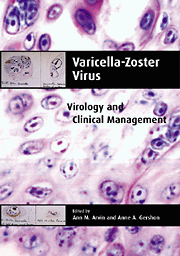Book contents
- Frontmatter
- Contents
- List of contributors
- Preface
- Introduction
- Part I History
- Part II Molecular Biology and Pathogenesis
- Part III Epidemiology and Clinical Manifestations
- 10 Epidemiology of varicella
- 11 Clinical manifestations of varicella
- 12 Epidemiology of herpes zoster
- 13 Clinical manifestations of herpes zoster
- 14 Ophthalmic zoster
- 15 Postherpetic neuralgia and other neurologic complications
- 16 Varicella and herpes zoster in pregnancy and the newborn
- Part IV Laboratory Diagnosis
- Part V Treatment and Prevention
- Index
- Plate section
13 - Clinical manifestations of herpes zoster
from Part III - Epidemiology and Clinical Manifestations
Published online by Cambridge University Press: 02 March 2010
- Frontmatter
- Contents
- List of contributors
- Preface
- Introduction
- Part I History
- Part II Molecular Biology and Pathogenesis
- Part III Epidemiology and Clinical Manifestations
- 10 Epidemiology of varicella
- 11 Clinical manifestations of varicella
- 12 Epidemiology of herpes zoster
- 13 Clinical manifestations of herpes zoster
- 14 Ophthalmic zoster
- 15 Postherpetic neuralgia and other neurologic complications
- 16 Varicella and herpes zoster in pregnancy and the newborn
- Part IV Laboratory Diagnosis
- Part V Treatment and Prevention
- Index
- Plate section
Summary
Herpes zoster (shingles) is a localized disease characterized by unilateral radicular pain and a vesicular eruption that is generally limited to the dermatome innervated by a single spinal or cranial sensory ganglion. In contrast to varicella, which follows primary exogenous varicella-zoster virus (VZV) infection, herpes zoster is the result of reactivation of endogenous VZV that had persisted in latent form within sensory ganglia following an earlier attack of varicella.
Herpes zoster (HZ) occurs most often in dermatomes in which the rash of varicella achieves the highest density – those innervated by the first (ophthalmic) division of the trigeminal ganglion and by spinal sensory ganglia from T1 to L2 (Head & Campbell, 1900; Stern, 1937; Denny-Brown et al., 1944; Hope-Simpson, 1965; Ragozzino et al., 1982; Donahue et al., 1995). Presumably, areas of skin with a denser rash during varicella transmit larger amounts of virus to the corresponding sensory ganglia, thereby endowing these ganglia with a higher concentration of latent VZV. If subsequent reactivation occurs at random, HZ would be expected to occur most frequently in dermatomes innervated by ganglia with the highest concentrations of latent VZV. The occurrence of HZ at sites of prior vaccination with live attenuated varicella vaccine is consistent with this model of VZV latency.
Although the latent virus in the ganglia retains its potential for full infectivity, reactivation is sporadic and infrequent, and infectious virus does not appear to be present during latency. The mechanisms involved in the reactivation of VZV are unclear (see Chapter 6), but a number of conditions have been associated with the occurrence and localization of HZ.
- Type
- Chapter
- Information
- Varicella-Zoster VirusVirology and Clinical Management, pp. 246 - 275Publisher: Cambridge University PressPrint publication year: 2000
- 23
- Cited by



